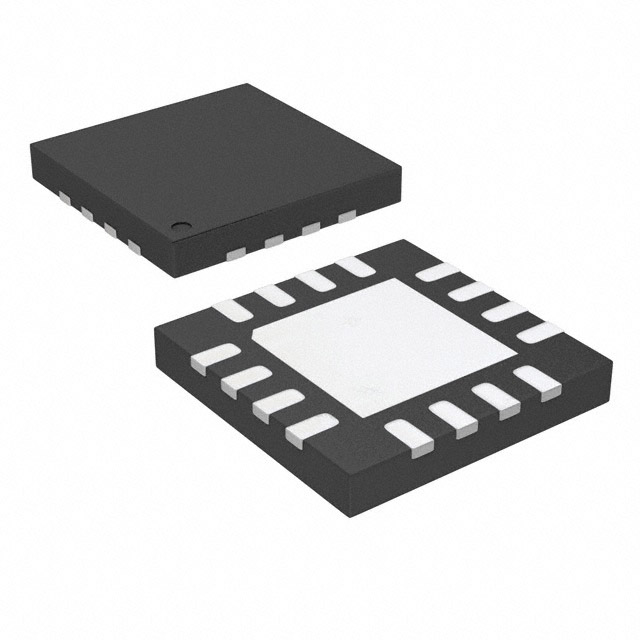LTC2966HUD#TRPBF
Product Overview
Category: Integrated Circuit (IC)
Use: The LTC2966HUD#TRPBF is a voltage monitor and supervisor IC designed for use in various electronic systems. It provides precise monitoring of multiple power supply voltages to ensure proper system operation.
Characteristics: - Monitors up to six input voltages simultaneously - Adjustable threshold levels for each monitored voltage - Wide operating voltage range - Low quiescent current consumption - Small package size for space-constrained applications
Package: The LTC2966HUD#TRPBF is available in a compact 16-pin QFN package, which offers excellent thermal performance and ease of integration into circuit boards.
Essence: The essence of the LTC2966HUD#TRPBF lies in its ability to accurately monitor multiple power supply voltages, providing an essential function in ensuring the reliable operation of electronic systems.
Packaging/Quantity: The LTC2966HUD#TRPBF is typically sold in reels containing a quantity of 250 units per reel.
Specifications
- Input Voltage Range: 2.7V to 80V
- Supply Current: 20µA (typical)
- Operating Temperature Range: -40°C to 125°C
- Threshold Accuracy: ±1.5%
- Output Type: Open-drain
- Package Type: 16-pin QFN
Detailed Pin Configuration
The LTC2966HUD#TRPBF features the following pin configuration:
- VCC: Power supply input
- GND: Ground reference
- VIN1: Input voltage 1
- VIN2: Input voltage 2
- VIN3: Input voltage 3
- VIN4: Input voltage 4
- VIN5: Input voltage 5
- VIN6: Input voltage 6
- OV1: Overvoltage output 1
- OV2: Overvoltage output 2
- OV3: Overvoltage output 3
- OV4: Overvoltage output 4
- OV5: Overvoltage output 5
- OV6: Overvoltage output 6
- GPO: General-purpose output
- FLT: Fault output
Functional Features
- Monitors multiple input voltages simultaneously
- Adjustable threshold levels for each monitored voltage
- Provides overvoltage detection and fault indication
- General-purpose output for system control or status indication
Advantages and Disadvantages
Advantages: - Precise monitoring of multiple power supply voltages - Adjustable threshold levels for flexibility - Low quiescent current consumption for energy efficiency - Compact package size for space-constrained applications
Disadvantages: - Limited to monitoring voltage levels, does not provide active voltage regulation
Working Principles
The LTC2966HUD#TRPBF operates by comparing the input voltages with the user-adjustable threshold levels. If any of the monitored voltages exceed their respective thresholds, the corresponding overvoltage outputs are activated. The fault output provides a global indication if any of the monitored voltages exceed their thresholds.
Detailed Application Field Plans
The LTC2966HUD#TRPBF finds applications in various electronic systems where precise monitoring of multiple power supply voltages is critical. Some potential application fields include: - Industrial automation systems - Telecommunications equipment - Automotive electronics - Power management systems - Medical devices
Detailed and Complete Alternative Models
- LTC2960: Monitors up to four input voltages, adjustable threshold levels, smaller package size.
- LTC2964: Monitors up to eight input voltages, adjustable threshold levels, higher accuracy.
- LTC2967: Monitors up to six input voltages, adjustable threshold levels, integrated power-on reset.
Note: This is not an exhaustive list of alternative models. Please refer to the manufacturer's documentation for a complete list of alternatives.
Word count: 439 words
Senaraikan 10 soalan dan jawapan biasa yang berkaitan dengan aplikasi LTC2966HUD#TRPBF dalam penyelesaian teknikal
Sure! Here are 10 common questions and answers related to the application of LTC2966HUD#TRPBF in technical solutions:
Q: What is LTC2966HUD#TRPBF? A: LTC2966HUD#TRPBF is a specific model number for a power supply monitor and supervisor IC manufactured by Linear Technology (now part of Analog Devices).
Q: What is the purpose of LTC2966HUD#TRPBF? A: The LTC2966HUD#TRPBF is designed to monitor various power supply parameters such as voltage, current, and temperature, and provide supervisory functions like power-on reset and fault detection.
Q: How does LTC2966HUD#TRPBF monitor power supply parameters? A: It uses built-in ADCs (Analog-to-Digital Converters) to measure voltage and current, and it can also interface with external temperature sensors to monitor temperature.
Q: Can LTC2966HUD#TRPBF be used in battery-powered applications? A: Yes, LTC2966HUD#TRPBF can operate in battery-powered applications as it has low quiescent current and supports wide input voltage range.
Q: What are the key features of LTC2966HUD#TRPBF? A: Some key features include undervoltage/overvoltage monitoring, overcurrent detection, temperature monitoring, adjustable thresholds, and programmable delay times.
Q: How is LTC2966HUD#TRPBF controlled or configured? A: It can be controlled through an I2C interface, allowing users to configure various settings and read back monitored values.
Q: Can LTC2966HUD#TRPBF generate interrupts upon fault detection? A: Yes, it has programmable interrupt outputs that can be used to trigger external actions or alert the system upon fault detection.
Q: What is the operating temperature range of LTC2966HUD#TRPBF? A: The LTC2966HUD#TRPBF can operate in a wide temperature range, typically from -40°C to +125°C.
Q: Can LTC2966HUD#TRPBF be used in high-voltage applications? A: Yes, LTC2966HUD#TRPBF supports a wide input voltage range, making it suitable for various high-voltage applications.
Q: Are there any evaluation boards or reference designs available for LTC2966HUD#TRPBF? A: Yes, Analog Devices provides evaluation boards and reference designs that can help users quickly prototype and evaluate LTC2966HUD#TRPBF in their applications.
Please note that the answers provided here are general and may vary depending on specific application requirements. It's always recommended to refer to the datasheet and application notes for detailed information.


